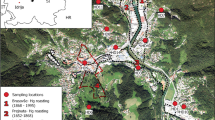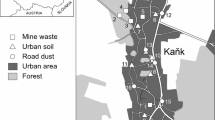Abstract
The laterite Ni ore smelting operations in Niquelândia and Barro Alto (Goiás State, Brazil) have produced large amounts of fine-grained smelting wastes, which have been stockpiled on dumps and in settling ponds. We investigated granulated slag dusts (n = 5) and fly ash samples (n = 4) with a special focus on their leaching behaviour in deionised water and on the in vitro bioaccessibility in a simulated gastric fluid, to assess the potential exposure risk for humans. Bulk chemical analyses indicated that both wastes contained significant amounts of contaminants: up to 2.6 wt% Ni, 7580 mg/kg Cr, and 508 mg/kg Co. In only one fly ash sample, after 24 h of leaching in deionised water, the concentrations of leached Ni exceeded the limit for hazardous waste according to EU legislation, whereas the other dusts were classified as inert wastes. Bioaccessible fractions (BAF) of the major contaminants (Ni, Co, and Cr) were quite low for the slag dusts and accounted for less than 2 % of total concentrations. In contrast, BAF values were significantly higher for fly ash materials, which reached 13 % for Ni and 19 % for Co. Daily intakes via oral exposure, calculated for an adult (70 kg, dust ingestion rate of 50 mg/day), exceeded neither the tolerable daily intake (TDI) nor the background exposure limits for all of the studied contaminants. Only if a higher ingestion rate is assumed (e.g. 100 mg dust per day for workers in the smelter), the TDI limit for Ni recently defined by European Food Safety Authority (196 µg/day) was exceeded (324 µg/day) for one fly ash sample. Our data indicate that there is only a limited risk to human health related to the ingestion of dust materials generated by laterite Ni ore smelting operations if appropriate safety measures are adopted at the waste disposal sites and within the smelter facility.



Similar content being viewed by others
References
Arita, A., & Costa, M. (2009). Epigenetics in metal carcinogenesis: Nickel, arsenic, chromium and cadmium. Metallomics, 1, 222–228.
Baars, A. J., Theelen, R. M. C., Janssen, P. J. C. M., Hesse, J. M., van Apeldoorn, M. E., Meijerink, M. C. M., et al. (2001). Re-evaluation of human-toxicological maximum permissible risk levels. RIVM report 711701025, Bilthoven, the Netherlands.
Bačeva Andonovska, K., Stafilov, T., & Karadjova, I. (2015). Assessment of trace elements bioavailability – ingestion of toxic elements from the attic dust collected from the vicinity of the ferro-nickel smelter plant. Contributions, Section of Natural, Mathematical and Biotechnical Sciences, MASA, 36, 93–104.
Bačeva, K., Stafilov, T., Šajn, R., & Tanaselia, C. (2012). Moss biomonitoring of air pollution with heavy metals in the vicinity of a ferronickel smelter plant. Journal of Environmental Science and Health, Part A, 47, 645–656.
Bierkens, J., Van Holderbeke, M., Cornelis, C., & Torfs, R. (2011). Exposure through soil and dust ingestion. In F. A. Swartjes (Ed.), Dealing with contaminated sites (pp. 261–286). Berlin: Springer.
Costa, M., & Klein, C. B. (2006). Toxicity and carcinogenicity of chromium compounds in humans. Critical Reviews in Toxicology, 36, 155–163.
Cox, S. F., Chelliah, M. C. M., McKinley, J. M., Palmer, S., Ofterdinger, U., Young, M. E., et al. (2013). The importance of solid-phase distribution on the oral bioaccessibility of Ni and Cr in soils overlying Palaeogene basalt lavas, Northern Ireland. Environmental Geochemistry and Health, 35, 553–567.
Crundwell, F. K., Moats, M. S., Ramachandran, V., Robinson, T. G., & Davenport, W. G. (2011). Extractive metallurgy of nickel, cobalt and platinum-group metals. Amsterdam: Elsevier.
Denkhaus, E., & Salnikow, K. (2002). Nickel essentiality, toxicity, and carcinogenicity. Critical Reviews in Oncology/Hematology, 42, 35–56.
Deshommes, E., Tardif, R., Edwards, M., Sauvé, S., & Prévost, M. (2012). Experimental determination of oral bioavailability and bioaccessibility of lead particles. Chemistry Central Journal, 6, 138.
Drysdale, M., Bjorklund, K. L., Jamieson, H. E., Weinstein, P., Cook, A., & Watkins, R. T. (2012). Evaluating the respiratory bioaccessibility of nickel in soil through the use of a simulated lung fluid. Environmental Geochemistry and Health, 34, 279–288.
EFSA. (2009). Scientific opinion of the Panel on Contaminants in the Food Chain on a request from the European Commission on cadmium in food. EFSA Journal, 2009(980), 1–139.
EFSA. (2010). Scientific opinion on lead in food. EFSA Journal, 8(4), 1570.
EFSA. (2014a). Scientific opinion on the risks to public health related to the presence of chromium in food and drinking water. EFSA Journal, 12(3), 3595.
EFSA. (2014b). Dietary exposure to inorganic arsenic in the European population. EFSA Journal, 12(3), 3597.
EFSA. (2015). Scientific opinion on the risks to public health related to the presence of nickel in food and drinking water. EFSA Journal, 13(2), 4002.
EN 12457–2. (2002). Characterisation of waste-leaching—Compliance test for leaching of granular waste materials and sludges, part 2. Brussels: CEN.
Ettler, V., Johan, Z., Kříbek, B., Šebek, O., & Mihaljevič, M. (2009). Mineralogy and environmental stability of slags from the Tsumeb smelter, Namibia. Applied Geochemistry, 24, 1–15.
Ettler, V., Kvapil, J., Šebek, O., Johan, Z., Mihaljevič, M., Ratié, G., et al. (2016). Leaching behaviour of slag and fly ash from laterite nickel ore smelting (Niquelândia, Brazil). Applied Geochemistry, 64, 118–127.
Ettler, V., Vítková, M., Mihaljevič, M., Šebek, O., Klementová, M., Veselovský, F., et al. (2014). Dust from Zambian smelters: Mineralogy and contaminant bioaccessibility. Environmental Geochemistry and Health, 36, 919–933.
EU. (1999). Council Directive 99/31/EC of 26 April 1999 on the landfill of waste. Official Journal of European Communities, L182, 1–19.
EU. (2003). Council decision of 19 December 2002 establishing criteria and procedures for the acceptance of waste at landfills pursuant to Article 16 of and Annex II to Directive 1999/31/EC. Official Journal of European Communities, L11, 27–49.
Gál, J., Hursthouse, A., Tatner, P., Stewart, F., & Welton, R. (2008). Cobalt and secondary poisoning in the terrestrial food chain: Data review and research gaps to support risk assessment. Environment International, 34, 821–838.
Gbefa, B. K., Entwhistle, J. A., & Dean, J. R. (2011). Oral bioaccessibility of metals in an urban catchment, Newcastle upon Tyne. Environmental Geochemistry and Health, 33, 167–181.
Goldhaber, S. B. (2003). Trace element risk assessment: Essentiality vs. toxicity. Regulatory Toxicology and Pharmacology, 38, 232–242.
Gražulis, S., Daškevič, A., Merkys, A., Chateigner, D., Lutterotti, L., Quirós, M., et al. (2012). Crystallography Open Database (COD): An open-access collection of crystal structures and platform for world-wide collaboration. Nucleic Acids Research, 40, D420–D427.
Heller, J. G., Thornhill, P. G., & Conard, B. R. (2009). New views on the hypothesis of respiratory cancer risk from soluble nickel exposure; and consideration of this risk’s historical sources in nickel refineries. Journal of Occupational Medicine and Toxicology, 4, 23.
Henderson, R. G., Cappellini, D., Seilkop, S. K., Bates, H. K., & Oller, A. R. (2012a). Oral bioaccessibility testing and read-across hazard assessment of nickel compounds. Regulatory Toxicology and Pharmacology, 63, 20–28.
Henderson, R. G., Durnado, J., Oller, A. R., Merkel, D. J., Marone, P. A., & Bates, H. K. (2012b). Acute oral toxicity of nickel compounds. Regulatory Toxicology and Pharmacology, 62, 425–432.
Kierczak, J., Néel, C., Puziewicz, J., & Bril, H. (2009). The mineralogy and weathering of slag produced by the smelting of lateritic Ni ores, Szklary, Southwestern Poland. Canadian Mineralogist, 47, 557–572.
Moore, P. (2012). Anglo’s new nickel. International Mining, March 2012, 20–24.
Morrison, A. L., & Gulson, B. L. (2007). Preliminary findings of chemistry and bioaccessibility in base metal smelter slags. Science of the Total Environment, 382, 30–42.
Morrison, A. L., Swierczek, Z., & Gulson, B. L. (2016). Visualisation and quantification of heavy metal accessibility in smelter slags: The influence of morphology on availability. Environmental Pollution, 210, 271–281.
Oliveira-Filho, E. C., Freitas Muniz, D. H., Ferreira, M. F. N., & Grisolia, C. K. (2010). Evaluation of acute toxicity, cytotoxicity and genotoxicity of a nickel mining waste to Oreochromis niloticus. Bulletin of Environmental Contamination and Toxicology, 85, 467–471.
Oliveira-Filho, E. C., Lima, L. S., Freitas Muniz, D. H., Ferreira, M. F. N., Malaquias, J. V., & Grisolia, C. K. (2013). Bioavailability assessment of metals from a nickel mining residue in the gastrointestinal tract of Oreochromis niloticus in vivo. Bulletin of Environmental Contamination and Toxicology, 91, 533–538.
Oller, A. R., Costa, M., & Oberdörster, G. (1997). Carcinogenicity assessment of selected nickel compounds. Toxicology and Applied Pharmacology, 143, 152–166.
Palmer, S., Cox, S. F., McKinley, J. M., & Ofterdinger, U. (2014). Soil-geochemical factors controlling the distribution and oral bioaccessibility of nickel, vanadium and chromium in soil. Applied Geochemistry, 51, 255–267.
Palmer, S., Ofterdinger, U., McKinley, J. M., Cox, S., & Barsby, A. (2013). Correlation analysis as a tool to investigate the bioaccessibility of nickel, vanadium and zinc in Northern Ireland soils. Environmental Geochemistry and Health, 35, 569–584.
Ratié, G., Quantin, C., Jouvin, D., Calmels, D., Ettler, V., Sivry, Y., et al. (2016). Nickel isotope fractionation during laterite Ni ore smelting and refining: Implications for tracing the sources of Ni in smelter-affected soils. Applied Geochemistry, 64, 136–145.
Reis, A. P., Patinha, C., Noack, Y., Robert, S., & Dias, A. C. (2014a). Assessing human exposure to aluminium, chromium and vanadium through outdoor dust ingestion in the Bassin Minier de Provence, France. Environmental Geochemistry and Health, 36, 303–317.
Reis, A. P., Patinha, C., Noack, Y., Robert, S., Dias, A. C., & Ferreira da Silva, E. (2014b). Assessing the human health risk for aluminium, zinc and lead in outdoor dusts collected in recreational sites used by children at an industrial area in the western part of the Bassin Minier de Provence, France. Journal of African Earth Sciences, 99, 724–734.
Ruby, M. V., Schoof, R., Brattin, W., Goldade, M., Post, G., Harnois, M., et al. (1999). Advances in evaluating the oral bioavailability of inorganics in soil for use in human health risk assessment. Environmental Science and Technology, 33, 3697–3705.
SCHER. (2012). Assessment of the tolerable daily intake of barium. Scientific Committee on Health and Environmental Risks. http://ec.europa.eu/health/scientific_committees/environmental_risks/docs/scher_o_161.pdf.
Tiesjema, B., & Baars, A. J. (2009). Re-evaluation of some human-toxicological maximum permissible risk levels earlier evaluated in the period 1991–2001. RIVM report 711701092, Bilthoven, the Netherlands.
US EPA. (2007). Estimation of relative bioavailability of lead in soil and soil-like materials using in vivo and in vitro methods. Office of Solid Waste and Emergency Response. OSWER 9285 (pp. 7–77). Washington, DC: US EPA.
USGS. (2016). Nickel. USGS Mineral Resources Program. http://minerals.usgs.gov/minerals/pubs/commodity/nickel/mcs-2016-nicke.pdf.
Vasiluk, L., Dutton, M. D., & Hale, B. (2011). In vitro estimates of bioaccessible nickel in field-contaminated soils, and comparison with in vivo measurement of bioavailability and identification of mineralogy. Science of the Total Environment, 409, 2700–2706.
Warner, A. E. M., Díaz, C. M., Dalvi, A. D., Mackey, P. J., & Tarasov, A. V. (2006). JOM World Nonferrous Smelter Survey, part III: Nickel: laterite. JOM Journal of the Minerals Metals and Materials Society, 58, 11–20.
Zelano, I., Sivry, Y., Quantin, C., Gélabert, A., Tharaud, M., Jouvin, D., et al. (2013). Colloids and suspended particulate matters influence on Ni availability in surface waters of impacted ultramafic systems in Brazil. Colloids and Interfaces A: Physicochemical Engineering Aspects, 435, 36–47.
Ziskind, G. (2006). Particle resuspension from surfaces: Revisited and re-evaluated. Reviews in Chemical Engineering, 22, 1–123.
Acknowledgments
This study was supported by the Czech Science Foundation project (GAČR 13-17501S) and was carried out in the framework of the Marie Curie International Research Staff Exchange Scheme Fellowship within the 7th European Community Framework Programme (NIDYFICS, no. 318123). Part of the equipment used for this study was purchased from the Operational Programme Prague—Competitiveness (Project CZ.2.16/3.1.00/21516). The staff of Anglo American at Codemin (Niquelândia) and Barro Alto provided access to the field facilities and kindly helped with the sampling. Petr Drahota helped with XRPD data acquisition, Zuzana Korbelová with SEM/EDS measurements, and Marie Fayadová with leaching and bioaccessibility tests. Peter Lemkin is thanked for revision of the manuscript. Valuable comments of two anonymous reviewers helped to improve the original version of the manuscript.
Author information
Authors and Affiliations
Corresponding author
Electronic supplementary material
Below is the link to the electronic supplementary material.
Rights and permissions
About this article
Cite this article
Ettler, V., Polák, L., Mihaljevič, M. et al. Oral bioaccessibility of inorganic contaminants in waste dusts generated by laterite Ni ore smelting. Environ Geochem Health 40, 1699–1712 (2018). https://doi.org/10.1007/s10653-016-9875-4
Received:
Accepted:
Published:
Issue Date:
DOI: https://doi.org/10.1007/s10653-016-9875-4




